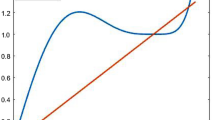Abstract
High-computing speed and modularity have made RNS-based arithmetic processors attractive for a long time, especially in signal processing, where additions and multiplications are very frequent. The VLSI technology renewed this interest because RNS-based circuits are becoming more feasible; however, intermodular operations degradate their performance and a great effort results on this topic. In this paper, we deal with the problem of performing the basic operationX(modm), that is the remainder of the integer divisionX/m, for large values of the integerX, following an approximating and correcting approach, which guarantees the correctness of the result.
We also define a structure to computeX(modm) by means of few fast VLSI binary multipliers, which is exemplified for 32-bit long numbers, obtaining a total response time lower than 200 nsec. Furthermore, such a structure is evaluated in terms of VLSI complexity and area and time figuresA=ϑ(n 2 T 2 m ) andT=ϑ(T M ) for the parameterT M in\([\log n,\sqrt n ]\) are derived. A simple positional-to-residue converter is finally presented, based on this structure; it improves some complexity results previously obtained by authors.
Similar content being viewed by others
References
M.A. Soderstrand, W.K. Jenkins, G.A. Jullien, F.J. Taylor, editors,Residue number system arithmetic: Modern applications in digital processing. New York: IEEE Press, 1986.
W.K. Jenkins and B.J. Leon, “The use of residue number systems in the design of finite impulse response digital filters,”IEEE Trans. Circuits Syst., vol. CAS-24, 1977, pp. 191–201.
M.A. Soderstrand, “A high-speed low cost recursive digital filter using residue number arithmetic,”Proc. IEEE, vol. 65, 1977, pp. 1065–1067.
W.K. Jenkins, “Techniques for residue-to-analog conversion for residue-encoded digital filters,”IEEE Trans Circuits Syst., vol. CAS-25, 1978, pp. 555–562.
W.K. Jenkins, “A highly efficient residue-combinatorial architecture for digital filters,”Proc. IEEE, vol. 66, 1978, pp. 700–702.
B.D. Tseng, G.A. Jullien and W.C. Miller, “Implementation of FFT structures using the residue number system,”IEEE Trans. Comput., vol. C-28, 1979, pp. 831–844.
C.H. Huang, D.G. Peterson, H.E. Rauch, J.W. Teague and D.F. Fraser, “Implementation of a fast digital processor using the residue number system,”IEEE Trans. Circuits Syst., vol. CAS-28, 1981, pp. 32–38.
M.A. Bayoumi, G.A. Jullien and W.C. Miller, “A VLSI model for residue number system architecture,”INTEGRATION, the VLSI journal, vol. 2, 1984, pp. 191–211.
G. Alia, F. Barsi and E. Martinelli, “A fast VLSI conversion between binary and residue systems,”Inform. Process. Lett., vol. 18, 1984, pp. 141–145.
G. Alia and E. Martinelli, “A VLSI algorithm for direct and reverse conversion from weighted binary number system to residue number system,”IEEE Trans. Circuits Syst., vol. CAS-31, 1984, pp. 1033–1039.
C.D. Thompson, “VLSI design with multiple active layers,”Inform. Process. Lett., vol. 21, 1985, pp. 109–111.
F.J. Taylor, “A VLSI residue arithmetic multiplier,”IEEE Trans. Comput., vol. C-31, 1982, pp. 540–546.
G. Alia, F. Barsi and E. Martinelli, “A fast near optimum VLSI implementation of FFT using residue number systems,”INTEGRATION, the VLSI journal, vol. 2, 1984, pp. 133–147.
G.A. Jullien, “Residue number scaling and other operations using ROM arrays,”IEEE Trans. Comput., vol. C-27, 1978, pp. 325–336.
F.J. Taylor, C.H. Huang, “An autoscaler residue multiplier,”IEEE Trans. Comput., vol. C-31, 1982, pp. 321–325.
K. Mehlhorn and F.P. Preparata, “Area-time optimal VLSI integer multiplier with minimum computation time,”Information and Control, vol. 58, 1983, pp. 137–156.
C.D. Thompson,A complexity theory for VLSI, Ph.D. Thesis, Carnegie-Mellon University, Computer Science Dept., Aug. 1980.
R.P. Brent and H.T. Kung, “The area-time complexity of binary multiplication,”JACM, vol. 28, 1981, pp. 521–534.
C.A. Mead and L.A. Conway,Introduction to VLSI systems, Reading, MA: Addison-Wesley, 1980.
R.P. Brent and H.T. Kung, “A regular layout for parallel adders,”IEEE Trans. Comput., vol. C-31, 1982, pp. 260–264.
N.S. Szabo and R.I. Tanaka,Residue arithmetic and its applications to computer technology, New York: McGraw-Hill, 1967.
Author information
Authors and Affiliations
Additional information
This work has been supported by the National Program on Solid-State Electronics and Devices of the Italian National Research Council.
Rights and permissions
About this article
Cite this article
Alia, G., Martinelli, E. A VLSI structure forX(modm) operation. J VLSI Sign Process Syst Sign Image Video Technol 1, 257–264 (1990). https://doi.org/10.1007/BF00929920
Received:
Revised:
Published:
Issue Date:
DOI: https://doi.org/10.1007/BF00929920




